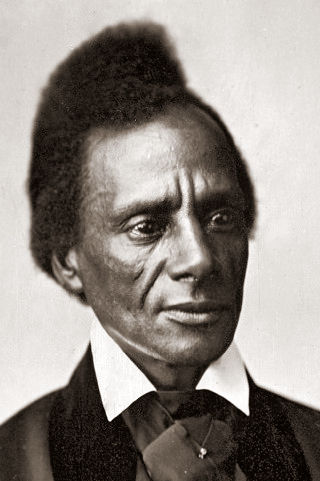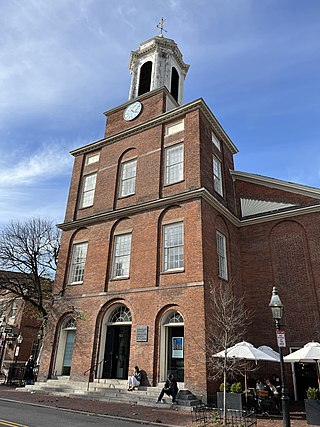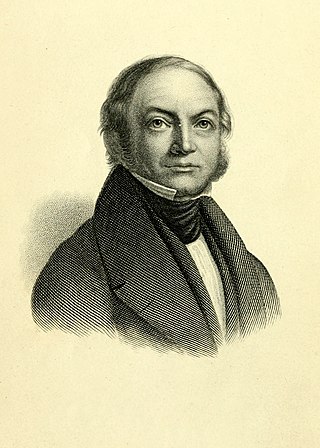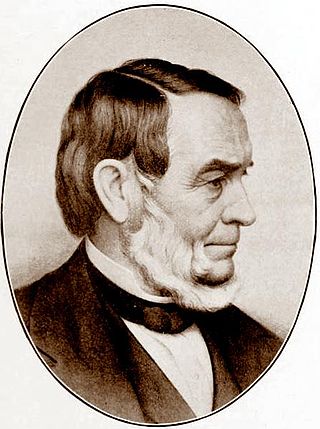
William Lloyd Garrison was an American abolitionist, journalist, and social reformer. He is best known for his widely read anti-slavery newspaper The Liberator, which Garrison founded in 1831 and published in Boston until slavery in the United States was abolished by the Thirteenth Amendment in 1865.

Charles Lenox Remond was an American orator, activist and abolitionist based in Massachusetts. He lectured against slavery across the Northeast, and in 1840 traveled to the British Isles on a tour with William Lloyd Garrison. During the American Civil War, he recruited blacks for the United States Colored Troops, helping staff the first two units sent from Massachusetts. From a large family of African-American entrepreneurs, he was the brother of Sarah Parker Remond, also a lecturer against slavery.

Theodore Parker was an American transcendentalist and reforming minister of the Unitarian church. A reformer and abolitionist, his words and popular quotations would later inspire speeches by Abraham Lincoln and Martin Luther King Jr.

The Universalist Church of America (UCA) was originally a Christian Universalist religious denomination in the United States. Known from 1866 as the Universalist General Convention, the name was changed to the Universalist Church of America in 1942. In 1961, it consolidated with the American Unitarian Association to form the Unitarian Universalist Association.

The First Unitarian Church of Rochester is located at 220 Winton Road South in Rochester, New York, U.S. The congregation is one of the largest in its denomination, the Unitarian Universalist Association. The non-creedal church conducts programs in the areas of spirituality, social concerns, music, and arts. This church is one of two Unitarian Universalist congregations in Monroe County, the other being First Universalist Church of Rochester.

The Charles Street Meeting House is an early-nineteenth-century historic church in Beacon Hill at 70 Charles Street, Boston, Massachusetts.

The First Unitarian Society of Madison (FUS) is a Unitarian Universalist congregation in Shorewood Hills, Wisconsin. Its meeting house was designed by Frank Lloyd Wright and built by Marshall Erdman in 1949–1951, and has been designated a U.S. National Historic Landmark for its architecture. With over 1,000 members, it is one of the ten largest Unitarian Universalist congregations in the United States.

Adin Ballou was an American proponent of Christian nonresistance, Christian anarchism, and Christian socialism. He was also an abolitionist and the founder of the Hopedale Community.

Charles (Karl) Theodor Christian Friedrich Follen was a German poet and patriot, who later moved to the United States and became the first professor of German at Harvard University, a Unitarian minister, and a radical abolitionist. He was fired by Harvard for his abolitionist statements.

First Parish in Cambridge is a Unitarian Universalist church, located in Harvard Square in Cambridge, Massachusetts. It is a Welcoming Congregation and a member of the Unitarian Universalist Association. The church is notable for its almost 400-year history, which includes pivotal roles in the development of the early Massachusetts government, the creation of Harvard College, and the refinement of current liberal religious thought.

Samuel Joseph May was an American reformer during the nineteenth century who championed education, women's rights, and abolition of slavery. May argued on behalf of all working people that the rights of humanity were more important than the rights of property, and advocated for minimum wages and legal limitations on the amassing of wealth.

First Parish Dorchester is a Unitarian Universalist congregation in Dorchester, Massachusetts. It was founded by English Puritans who initially saw themselves as reformers rather than separatists, but increasingly intolerable conditions in England and at the urging of Reverend John White of Dorchester, Dorset, they emigrated to New England. On March 20, 1630 as they set sail from Plymouth, England on the Mary and John, the congregation wrote its founding church covenant. Nearly all of the 140 ship passengers originated in the West Country counties of Somerset, Dorset and Devon. In late May, the ship landed first at what became called Hull, Massachusetts, and then in June at a place called "Mattapan" by the indigenous people including the Massachusett and Wampanoag. The Puritans named their new home "Dorchester Plantation."

The Unitarian Universalist Church of Medford and The Osgood House are a historic Unitarian Universalist church building and parsonage house at 141 and 147 High Street in Medford, Massachusetts.

George Bradburn was an American politician and Unitarian minister in Massachusetts known for his support for abolitionism and women's rights. He attended the 1840 conference on Anti-Slavery in London where he made a stand against the exclusion of female delegates. In 1843 he was with Frederick Douglass on a lecture tour in Indiana when they were attacked. Lydia Maria Child wrote with regard to his work on anti-slavery that he had " a high place among the tried and true."

First Parish Church in Plymouth is a historic Unitarian Universalist church at the base of Burial Hill on the town square off Leyden Street in Plymouth, Massachusetts. The congregation was founded in 1620 by the Pilgrims in Plymouth. The current building was constructed in 1899.

Thomas Paul (1773–1831) was a Baptist minister. In 1805, he became the first pastor for the First African Baptist Church, currently known as the African Meeting House in Boston, Massachusetts. He later helped found the Abyssinian Baptist Church in New York City. An abolitionist, he was a leader in the black community and was an active missionary in Haiti.
Thomas Treadwell Stone was an American Unitarian pastor, abolitionist, and Transcendentalist.

William Adam was a Scottish clergyman, missionary and abolitionist.

Church of Our Father was the first Unitarian church established in Atlanta, Georgia. The church was organized on March 27, 1883, by Rev. George Leonard Chaney, a Boston minister. Rev. Chaney initially held Sunday services in the Senate Chamber, Concordia Hall and the United States Courtroom. A church building was constructed at the corner of North Forsyth and Church Street and dedicated on April 23, 1884. The original building was demolished in 1900.



















